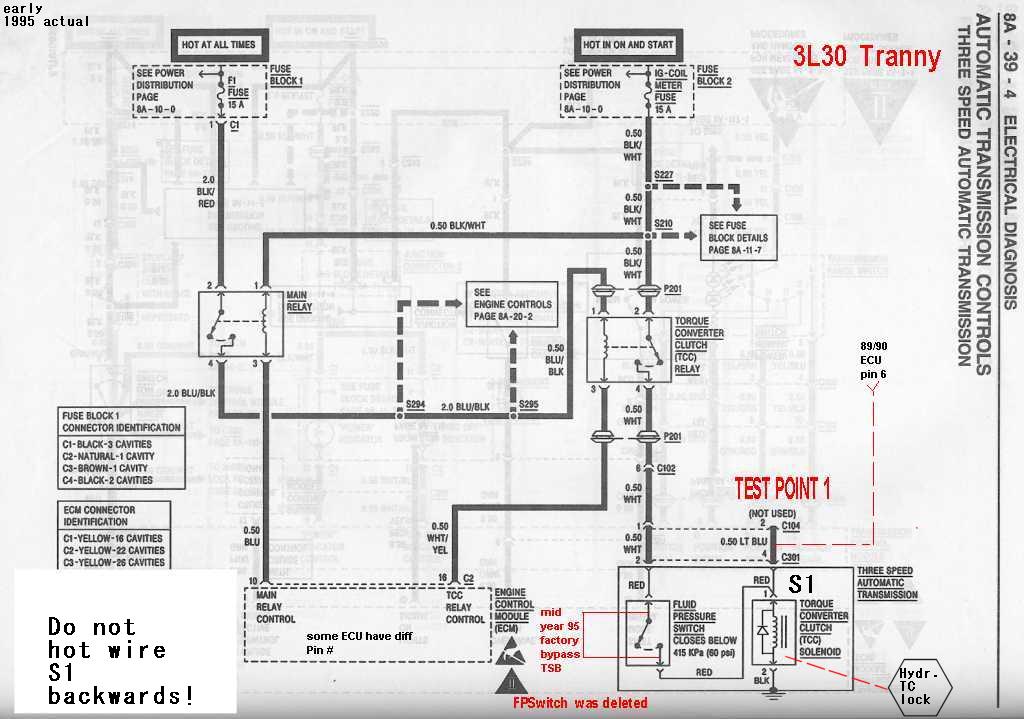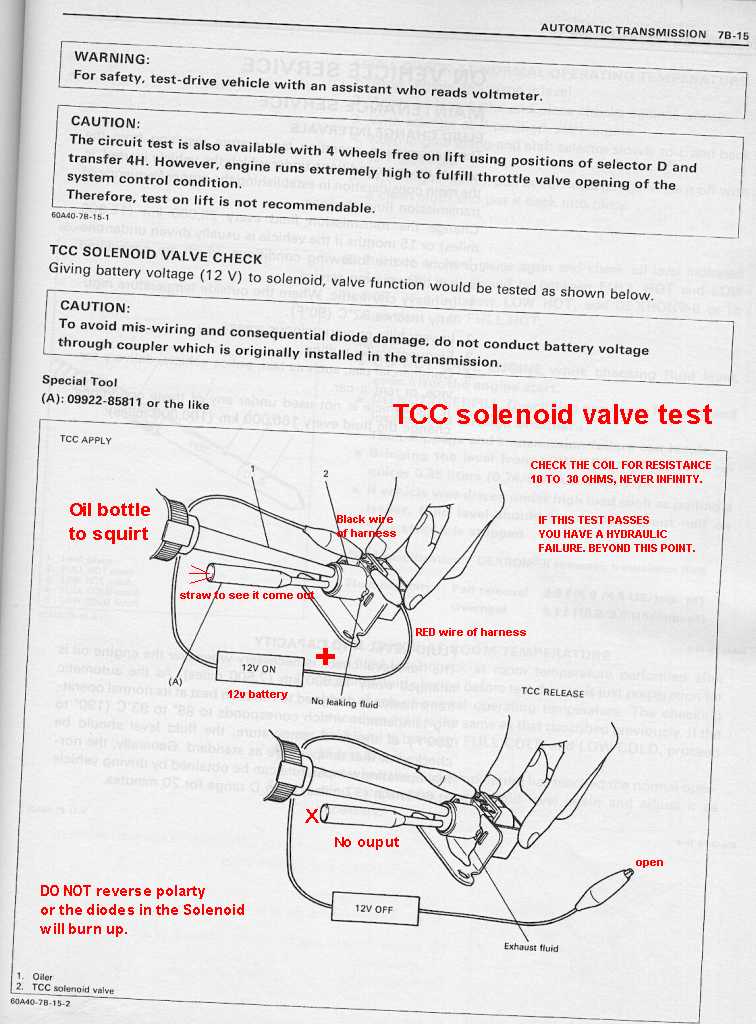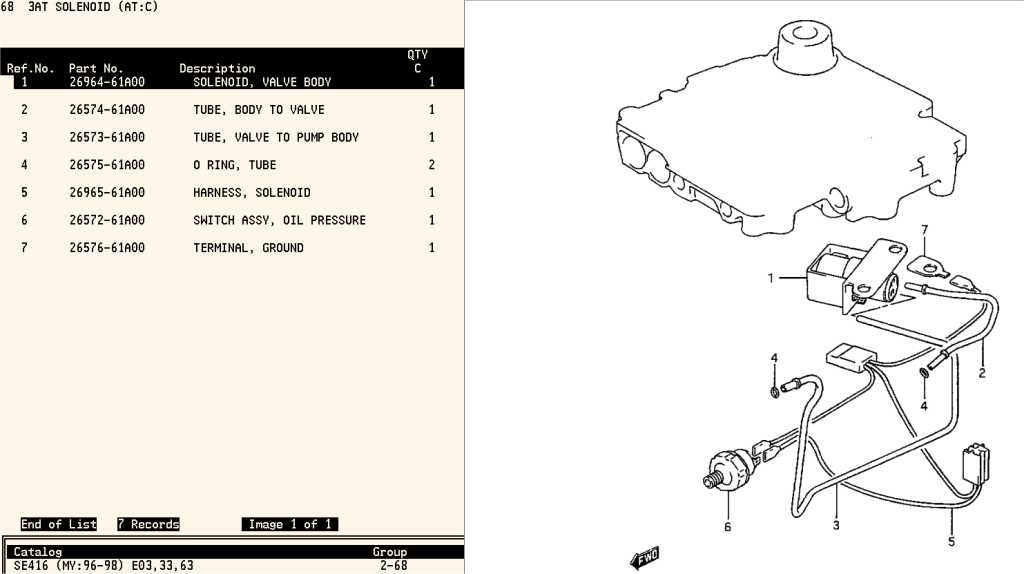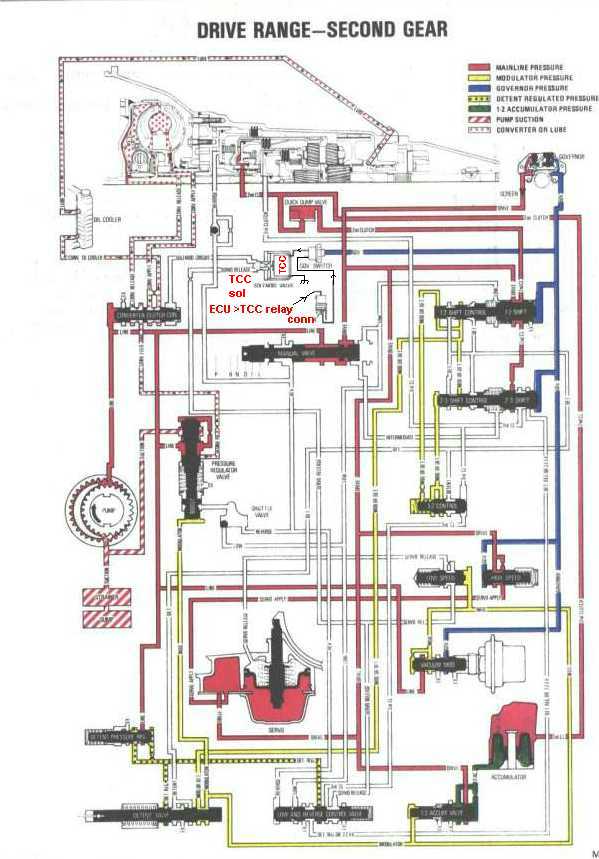
TCC lockup failures:
The transmission clutch locks up in certain speeds, on a 3speed it can occur at 47mph . or The 4speed TCC follows these rules.
Some folks come here for cars made in 1996, that can pass (CEL stuck on) the smog tests, and their PCM throws P074x or P077x DTC errors. (any error with the words, LOCK in them)
Or you notices the TCC was dead driving ?
The TCC can lock up as low as 32 mph and drop out, as low as 29 mph.
The ECU monitors the trans tail shaft speed (VSS sensor) and shifts the TCC at specific engine loads and speeds.
There are many TSBs for SIDKICK A/T tranny's, this is a partical list, TSBs that address this TCC function. including the Pressure switch baypass, done to all 3L30's.
To find the TCC relay on the top right fender of the car, look here (91-95) :
Jump to here for 4speed TCC wiring.
This first review and tests covers only the electrical side and how to discover which side is failing, Is it electrical or hydraulic failure. (all electric fails are easy find to fix, compared to , say a new A/T or full overhaul)
A Review:
(tools, any DMM meter , a cheap Stethoscope, and a jumper wire with inline 15amp fuse and a switch added in series with this jumper wire.)
You CAN: (3L30) (do ohms tests, and passive tests (monitors I set up) and active hot wire tests, all work well to find true cause of failure.
Meter black test lead is at transmission casing metal ground, (clipped there).
- Make darn sure the transmission ground strap is not missing or damaged in any way. Or the Solenoid may fail.
- Replace filter or clean bottom pan filter screen to get better line pressure.
- See
if the car body side (ECU (PCM) or it's fender relay, is bad or is the
problem inside the tranny? Replace this relay if the TCC is intermittant or dead or the output never goes to 13v to 15vdc driving
- The C301 pin 4 wiring inside the transmission can be
missing. On later years. (because the pressure switch was deleted
1996 at the factory)
- If the pressure switch is present it must be bypassed NOW.
- Unplug C301 , and measure the ohms {resistance } (red meter test lead to pin 2 and 4 ONE PIN, must pass this test. ) and see if the solenod coil is not open or shorted. Meter black test lead to transmission casing.
- If you discover that the pressure switch is still wired, I never fail to do the TSB procedure now, (jumper bypass the internal pressure switch wires) At this point the pin 2 measures 10-30ohms,
- Parked ,keys in pocket , connector pulled, use an ohm meter
at the C301 pin 2 ten 4, if it reads 10-30 ohm or near its
ok. if not the coil is open or this wire is not pressent,
inside.(common on newer transmissions pin 4 is not wired)
- If the pressure switch inside was not bypassed back in 1995 (89-95) only pin 4 measures correctly.
- Starting in 1996 only the pin 2 (C301) is wired, so only test this pin. (keep in mind, many cars MAY have transmission swaps, or are never been above TSB revised)
- The next tests are hot wiring test. The next tests works on all, three speeds tansmissions. The hot wire tests, can be done 2 ways, one for click sound parked, and with jumper wires driving.
- Remember pin 2 is dead, parked, on older cars, not TSB modified.
- Parked ,keys in pocket , connector pulled, hot wire (jumpered +12vdc{fused}) to, pin 4, if the ohms tests above is ok or pin 2 if TSB modified,, you might hear the solenoid click inside?, for sure clicks with a stethoscope to your ear and side of casing.
- Next, is a passive test. (no hot wiring,)
- You can connect a long test wire, spliced to the
WHITE wire. near trans casing plug connector (ohms test passes
above)
- Drive above 47mph and measure the pin2 wire (White) with any DMM volt meter set to 12vdc, and drive flat road, light cruise, and make real sure this wire jumps to +13-15vdc as the PCM enables, TCC lockup, per speed charts. If not?, the fender relay is probably bad.
- If the white wire goes hot in TCC lock mode above, and the TCC fails, the problem is inside the transmission. (TCC solenoid is top suspect, pressure switch bypassed)
- In the same vein {setup}, you can hot wire that same white wire (cut the wire or pull the TCC relay from fender socket) and force TCC lockup at any speed, you want. (+12vdc appled with the fused jumper wire tool)
- As you can see , there are lots of things to do and try.
(proving problem is outside or inside the transmission casing) (in all
transmissions modified to no pressure switch, the pin 2 pin, must read
10-30 ohms or near of the solenoid is bad , coil bad)
- You can replace the bad bad or missing O-rings on the solenoid for 50 cents.
- Remove
the TSB Delay module if found(bypass the white wire) , this is a TSB ADDED, anti-buck relay, it may cause 1996 and newer cars to fail of used. Get ride of it , if you have P07xx codes.
- Replace the TCC fender relay at the get go, they dont last long,
the contacts burn.
- Look for a modified TCC wires , added switches, owners added to turn OFF TCC when towing trailers. (so it don't do the TCC hunt and buck to death trick) Just follow the TCC harness cable and look for hacking here.
- If all tests above pass, and a new solenoid does not fix dead TCC, sadly the actual TCC lock hydraluic valve is dead (seems rare this)
- Ok your are deep inside now, the 3SP box.See more tests here, for pan off tests.
Warning : Do not hot wire the TCC soleniod in the reverse polarity or you will burn up the internal DIODE clamps. Only Plus voltages belong on the transmisson, pin connectors.
If you do hot wire it with PLUS 12vdc battery jumper, to the white wire, do pull the fender relay, or if real new 96+ car, pull the connector on the tranny case and hot wire to case , protecting TCM (4speed) or ECU/PCM
The relay can be pulled and hot wired there more easy. (relay socket pin 4 , white)
3L30 or TH180 mean 3 speed transmission.
Things to do before removing transmission or pull the pan, pan drop is always last ! why take a bath in ATF.? Monitor the LT.BLUE wire FIRST (with a LED, Voltmeter or test lamp)
1991 to 1998 ( TCC solenoid is wired slightly differently in 1989-90 transmissions and ECU has TCC feed back connections to the LT blue wire, but is activated the same way on the white wire)
The TCC locks up at about 47 MPH cruising on flat ground , this changes by the load on engine and tranny. (making brake lights go on , drops TCC in 1 instant (the best way to test if TCC is working right.)
{there are some 4speed comments}
On the 3speed Sidekicks the ECU detects the need for TCC look up and then Energizes the TCC relay. ( the 4speed in 97'+ Kicks moved the TCM (4sp) to inside the ECU/PCM and uses direct drive TCC, no more relay)
The TCC relay then sends 12vdc power to the transmission connector and in to the TCC oil pressure switch. ( starting in mid year 95 this switch was eliminated or was bypassed with older written TSB's.)
Many people pulling boats or the like complained of TCC hunting , so many cars are equipped with a delay device (TSB) or a switch (hack) or the removal of the oil pressure switch as directed by many TSB papers from Suzuki and GM.
It goes with out saying, if the transmission ground strap is missing (near tail shaft ) , the TCC will fail. (now or soon) Put it back now. Beef it up (gringo slang)
The TCC relay is in front of the battery. and on the right side of the bank group ( drivers perspective)
3 speed TCC: Circa early 1995 just before the TSB revisions to 3L30 , by removing the pressure switch.
In 1996 or 7, the Relay Clutch, was deleted, and the TCM drives the white wire with a powerful transistor, inside TCM. In 1997 The TCM was moved inside the ECU.
The part marked Solenoid is not really a solenoid, it's a Hydraulic Electromagnetic valve, that feeds full line AFT pressure to the TC hydraulic clutch.
Drawing 1: (I added the diode to the drawing so you can see it and not blow it up) At S1. The red dotted line is a hydraulic line the actual LOCK. The newer cars have no TEST POINT 1;

1996 the drawing changed (3sp) to this. Note Pin 1 changes at TCC solenoid, below)
Drawing 2: (you can see what they did below , in 1996 and on all TSB modifed 3SP transmissions.
Tests for 3sp TCC: (revised)
Test 1: (ohms , Homes?)
Always check the SOLENOID coil first: you can check the Solenoid, coil resistance, with the car parked. and keys in pocket.
The testing is only complex due to year, and if modified by TSB or not.
- New transmissions have no light blue pin wiring at all. (inside transmission)
- The older TSB modified trans both pins read 10-30ohms. (white and light-blue) but only the white pin matters.
- Old transmission say before 1996 both pins are wired inside.
- Keep in mind all old TSB modifed transmissions, both pins must read 10-30 ohms parked , keys in pocket or the soleniod is bad.
- All old transmission (virgin) will read 10-30 ohms , key off, at light-blue wire only. Telling coil is ok.
From this point on, all transmission read correct at the white wire, (TSB modified by you, someone else or from the factory (96+)
The meter ohms must read 10-30 ohms or about. not infinity. use the meter red lead on the White wire . (disconnected) and meter minus lead to trans casing metal ground.
If white wire, reads infinity, key off, the wires inside are bad or the TCC solenoid is bad. !
The solenoid is Polarized). DO not hot wire it backwards.
Test 2: (TSB pressure switch is done) Passive tests.
See the Solenoid in the above drawing, that is just part of the story, this Solenoid is really a Hydraulic electromagnetic valve that applies full oil pressure to the TCC lock in the clutch, causing TC lockup.
The testing is best done with a test lamp ( because the low resistance path to the Solenoid my be open) and a high impedance meter will read wrong due to leakage to pin 2 on the relay.
The first test is to make sure, that 12vdc (13-15v)power is present at the White wire at 47+ MPH. (use a test light on a long wire is best way to do that, with minus test meter lead, to body a good metal ground.)
The white wire test from relay to transmission,
How to do this varies by your choice.
At the relay , a connector or at the transmission.
One easy way, is at the RELAY pin 4, attache a wire (long) to this terminal. some way.
I run said wire to the passenger seat.
I connect the 12volt (no battery type) test light. to this wire and other end of light to body ground. ( you can make a test light form an old 194 side marker lamp and 2 wires soldered on to it.
I drive and as I get to near 47 MPH the light must go on, for sure at 50 MPH, on flat ground with easy throttle actions. (not WOT, or going up hill) This is the LOCK UP COMMAND form the ECU.
If it glows then the Solenoid is failing or deeper!
If no GLOW ? there , then the relay is bad. (I'im sure the ECU is ok)
If the relay is known good,(new)?
Then check that RELAY pin 3 goes to ground at 47mph (DMM volts), if not, the ECU is bad, or you forgot that a cold motor dont activate TCC. Nor does ECU with a DEAD VSS. etc... Other DTCs errors most not be set. Fix them first before TCC errors are suspect.
Active testing.
TEST 2B , we can hot wire the white wire driving (relay pulled) and see that TCC locks or not, Use a jumper wire 18gauge, 15amp inline fuse and a cheap toggle switch. to the white wire, drive and throw the switch on and bam, TC must look.
Preliminary road tests:
Check for TCC lockup driving.
Cruising with foot steady over 47mph .
( drive get TCC to lock up (you think) and depress the brake pedal, ever so gently, to see if TCC un locks and engine RPMs rise) that means it's working.
The brake switch , cancels TCC ! do not actually apply brakes and slow down with brakes only get the brake switch to click closed. (a mis adjusted brake switch makes this test impossible) Set the switch for early closure.
end prelim.
Deep inside:
The next photo below shows the actual solenoid and the pre 1995 FSM tests.
You need to drop the oil pan (no drain plug) and capture 3 qts of ATF carefully. (add a store bought drain plug now)
First, see if you have a pressure switch, before the below valve, is wired up? (if tranny is a 96 or newer , will not this switch, if transmission is a true 1996, if it has it ,delete it and bypass it.!)
Next make sure all wires to the TCC solenoid are in good condition and pass conductivity tests.
Finally check the coil for about 10 - 30 ohms resistance. ( not open circuit or infinity reading !)
Check that 12vdc applied to the 2 wires, makes it click by sound. (if not , its jammed)
The Later cars sometime after 1995 and for sure at 1997, This solenoid no longer can be tested per Drawing #3, I think this is because the input needs full pressure, or say 30 PSI for the solenoid to actually close.
In this case it is best to just replace it on suspicion. (pans off already , so....)
From 1989 to 1995:
Pull the solenoid and test it as the below FSM page shows.
Do not test it , with power reversed. or it will burn up the internal diode clamps , once this happens, damage can cascade.
The TCC Solenoid On the bench solenoid test, please check the coil first , if open?, dont bother going further.! Open is near infinity, or way over , say 50 ohms (coils can fail in many ways, open ,short, or go way higher in resistance)
1st:
Use an ohm meter and check for 10-30 ohms and never blown open to infinity. Test 2 above above, covers this.
Drawing 3:

If the Solenoid passes the coil test and the clicks with power test and the no leak and does open and closed test ,then it is good.
If the solenoid side good, then the hydraulic side is bad on the output of this solenoid valve.
The Oil line o-rings can be split or the actual TCC lock may be bad. The new solenoid comes with fresh 0-rings and as you can see , Suzuki sells them too. ID #4
The solenoid valve apples pressure to the Converter clutch lock control valve and other parts , parts that can fail.
As you can see even one 10 cent 0-ring id# 4 can make the TCC fail.
Any failure beyond hose ID 3, is a complex hydraulic , mechanical failure that is deep buried and beyond my scope, of "ON CAR TRANNY REPAIRS."
To tell the truth, once I get these, deep , bottles of fresh ATF oil. in hand, new pan gasket, new filter or screen cleaned, just buy a new solenoid valve before the job, and put one it, if TCC ever even hickups.
Some new above new solenoid valves, come with pipes, that must be bent to fit, good luck there.. not kinking them.
Drawing 4: Parts list of Solenoid section:
This drawing is 1989 to 1995, Before TSB actions.
The TSB just deletes part 6 and bypasses it ( best, is to just short the 2 pins on ID 6 below) I'd just pull those to Fastons(tm) connectors (@#6) and the cut the 2 wire at them and solder and heat shrink splice them.
The funny object below at center, between the two #4 part is just a splice.
Some newer transmisions do not have the 2nd wire at #5 connector. (the test wire, or can be used to bypass #6 at the connector above #5) with no transmission pan drop.

Drawing 5:
Last: here is the hydraulic map. The Clutch solenoid is upper center, see the complexity to the left of this device.
The pressure switch should be bypassed on all 3L30s after 1995 , and before if you are smart. The TSB explains all those facts. Read it.

TSB's that cover this transmission and others are here HIGH RESO, and here Low RESO.
The TSB above covers 1992 to 98 years.
4 SPEED only: A 100% Electronically shifted transmission. Using only 3 Solenoids and a TCM (or virtual TCM inside the PCM)
The 1992-96, 4 speed runs a TCC relay just like the above and is driven by the TCM and NOT the ECU. ( all 3speed cars the TCC is driven as per above information)
Starting in 1997 the TCC relay was deleted and the TCM (deleted) and was moved inside the PCM(ECU).
The 4speed in 97+ is operated 100% direct drive to all 3 solenoids in the tranny. (the first 2 solenoids, shift tranny and the last is TCC solenoid , green-yellow wire pin 16 on PCM)
In 97 the name ECU is now a PCM. (does it all , engine and tranny)
4speed.... detail drawings, I made for TCC failures.
1996
1997-98
end 4sp.
Do not put the meter backwards or the diodes will conduct and get a wrong reading (shorted) Black meter test lead must be on the tranny CASing. (no danger here, just false readings)
The Pressure switch is here, just below brass screen, remove the to Faston(tm) connectors, and short them.
The Solenoid is the the left. Many years, have 2 wires (early)a at the connector center right, wire the TCC fender relay to the pin (below) that read about 30 ohms. (and win)
Photo #1 This newer transmission has no 2nd wire at the input connector bottom right. Note pressure switch in this case ,switches ground. Bypass those 2 red connectors.

Below is the fender relay banks. Replace relay 2 at any TCC suspicions. and if the delay module is found, get rid of if by undoing the TSB that put it there, this device can make you fail smog, if you get P740 errors.(etc)

rev 6 ++++ add TSB, pdf